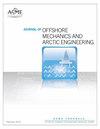A Study of Offshore Wind Turbine Wake Effects in Yaw Conditions Using an Improved Actuator Line Method
IF 1.3
4区 工程技术
Q3 ENGINEERING, MECHANICAL
Journal of Offshore Mechanics and Arctic Engineering-Transactions of the Asme
Pub Date : 2023-01-19
DOI:10.1115/1.4056519
引用次数: 1
Abstract
Abstract The study of wind turbine wakes is very important for the layout of offshore wind farms. The technique of regulating the yaw angles of the upstream wind turbine to lessen the influence on the downstream turbines has attracted continual attention in recent years. In this study, the wake interactions between a yaw wind turbine and a downstream wind turbine are investigated using a numerical technique based on the openfoam solver in conjunction with an improved actuator line method. The Gaussian anisotropic body force projection method and the integral velocity sampling method are the two fundamental components of the improvement of the actuator line method. The NREL 5-MW wind turbine benchmark model is used to test the numerical accuracy. The simulation of the wake effects from the upstream turbine in non-yawed conditions that follows has good agreement with the results that have been published in the literature. Finally, this work presents a number of predictions about the power coefficients and wake characteristics of two tandem-arranged wind turbines at various yaw angles based on these precise verification efforts. The results of the analysis in yaw conditions are used to derive the yaw wake characteristics and the optimal yaw angle range. As the yaw angle increases, the total power of the wind turbine increases and then decreases, and the upstream wake area decreases significantly. The total power reaches its maximum at 20–30 deg. The research content of this paper will provide an important reference for wind farm scheduling.基于改进致动器线方法的海上风力机偏航尾迹效应研究
风力机尾迹的研究对海上风电场的布局具有重要意义。通过调节上游风力机的偏航角来减小对下游风力机的影响,近年来一直受到人们的关注。本文采用基于开放泡沫求解器的数值方法,结合改进的致动器线法,研究了偏航风力机与下游风力机之间的尾迹相互作用。高斯各向异性体力投影法和积分速度采样法是执行器线法改进的两个基本组成部分。采用NREL 5-MW风电机组基准模型对数值精度进行了验证。本文对上游涡轮在非偏航条件下的尾迹效应进行了仿真,与已有文献的结果吻合较好。最后,基于这些精确的验证工作,本工作提出了关于两个串联风力涡轮机在不同偏航角下的功率系数和尾迹特性的一些预测。利用在偏航条件下的分析结果,推导出了偏航尾迹特性和最佳偏航角范围。随着偏航角的增大,风力机总功率先增大后减小,上游尾迹面积明显减小。总功率在20 ~ 30度时达到最大。本文的研究内容将为风电场调度提供重要参考。
本文章由计算机程序翻译,如有差异,请以英文原文为准。
求助全文
约1分钟内获得全文
求助全文
来源期刊
CiteScore
4.20
自引率
6.20%
发文量
63
审稿时长
6-12 weeks
期刊介绍:
The Journal of Offshore Mechanics and Arctic Engineering is an international resource for original peer-reviewed research that advances the state of knowledge on all aspects of analysis, design, and technology development in ocean, offshore, arctic, and related fields. Its main goals are to provide a forum for timely and in-depth exchanges of scientific and technical information among researchers and engineers. It emphasizes fundamental research and development studies as well as review articles that offer either retrospective perspectives on well-established topics or exposures to innovative or novel developments. Case histories are not encouraged. The journal also documents significant developments in related fields and major accomplishments of renowned scientists by programming themed issues to record such events.
Scope: Offshore Mechanics, Drilling Technology, Fixed and Floating Production Systems; Ocean Engineering, Hydrodynamics, and Ship Motions; Ocean Climate Statistics, Storms, Extremes, and Hurricanes; Structural Mechanics; Safety, Reliability, Risk Assessment, and Uncertainty Quantification; Riser Mechanics, Cable and Mooring Dynamics, Pipeline and Subsea Technology; Materials Engineering, Fatigue, Fracture, Welding Technology, Non-destructive Testing, Inspection Technologies, Corrosion Protection and Control; Fluid-structure Interaction, Computational Fluid Dynamics, Flow and Vortex-Induced Vibrations; Marine and Offshore Geotechnics, Soil Mechanics, Soil-pipeline Interaction; Ocean Renewable Energy; Ocean Space Utilization and Aquaculture Engineering; Petroleum Technology; Polar and Arctic Science and Technology, Ice Mechanics, Arctic Drilling and Exploration, Arctic Structures, Ice-structure and Ship Interaction, Permafrost Engineering, Arctic and Thermal Design.

 求助内容:
求助内容: 应助结果提醒方式:
应助结果提醒方式:


